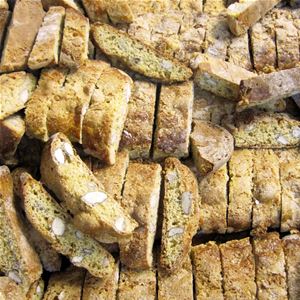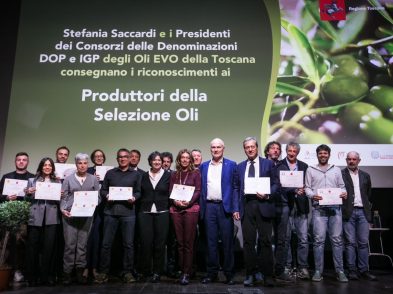At the end of just about any meal in Tuscany, be it at home or at a restaurant, chances are you’ll be offered cantucci and vin santo. Let’s look at the history of these two delicacies – both of which date back hundreds of years – and how they are made.
Biscotti vs. Cantucci di Prato
Cantucci—what most Americans refer to as ‘biscotto’—has its origins in Prato during the Renaissance. During the Roman Empire, biscotti—from the latin ‘bis’, meaning twice, and ‘coctum’, meaning baked—were created to sustain the Roman League soldiers during long marches into battle. The unleavened wafers, flavoured with almonds which at the time were plentiful, were baked once to cook them and again to completely draw out the moisture, resulting in a hard, dry texture and a shelf-life so long that the philosopher Pliny the Elder once reportedly boasted that they would be edible for centuries. When the Roman Empire collapsed, the cookies disappeared until the Renaissance.
The reemergence of biscotti began when cuisine blossomed in Tuscany, along with everything else; the reintroduction of the Roman treat is attributed to a Pratese baker who recreated the same almond-flavoured biscotti (because of the plentiful almond groves that grew in Prato) that had once fuelled and sustained the soldiers of the Roman Legions, but instead paired it with a local sweet wine, turning the emergency-fuel snack into a dessert to be savoured and enjoyed. Renamed ‘cantucci’ by the Tuscans, it became a delectable staple in Florence and Prato, and was enjoyed by the fisherman, sailors, and soldiers of the Renaissance for the same reason it was enjoyed by the Romans.
Flavours quickly expanded, limited only to what lay within the imagination of Tuscan bakers. Doughs were flavoured with anisette, lemon and amaretto. Other spices were incorporated in the recipes. Almonds lost their ubiquity to other varieties of nuts and dried fruits such as raisins, figs, dates and quince. Chocolate morsels were added.
Nowadays, cantucci are a supermarket staple and something that most families keep at home. The hard, long-lasting version is preferred by some, while many artisan cookie-makers are leaning towards a softer, less tooth-breaking version. One of these is Dolci Amari, owned by twin sisters Lorella and Mariella Amari, who set up shop in 2003 in Carmignano, just outside of Prato. Their cantucci, in numerous variations, are available at fine food stores in Italy, and in the USA they are imported by Mi Garba, the authentic Tuscan wine bar and cafè in the Union Square area.
Lorella Amari told us “A delicious, authentic cantuccio is not too hard, and not too sweet. It’s the perfect tool for dipping into a good vin santo (though it’s good on its own, too).”
Vin Santo
For many Tuscans, vin santo is cantuccio’s best friend and the perfect end to a meal, although some winemakers would rather see their sweet wine enjoyed without auxiliaries, since it’s rather complex to make and deserves attention of its own.
The term vin santo translates directly as saint’s wine, not because it may save you, but due to one of two possible origin stories. The Sienese say it dates back to its use to cure people of the plague in 1348, while the Florentines believe it stems from the misunderstanding of the word xanthos spoken by a visiting Greek priest in 1439.
This wine, that dates back to the Middle Ages, is made of Trebbiano and Malvasia white grapes which are harvested in the late fall and air-dried on straw mats until the start of Holy Week, growing in sugar content the whole time. Once bottled, Vin Santo ages for three to twelve years in small barrels, where it encounters the mother must of previous batches of the sweet stuff. Vin Santo is costly because it’s labour intensive, though if you want something even more rare and expensive, you’ll want the Occhio di Pernice variant made with Sangiovese grapes by only a select few Tuscan producers.
We asked wine consultant Fabrizio Ialini what to look for in a good vin santo: ‘Look for an amber colouring, from light to intense, with perfumes of dried fruit and resin, which in the mouth is warm, almost creamy, with a persistent aftertaste.’
Terre di San Gorgone, a family-run producer of vin santo located just a few kilometres outside of Florence, whose traditions of winemaking are handed down across generations, from father to son, is so good it’s even served in Mi Garba, a concept store, wine bar, and café in New York’s Union Square Area. Their vin santo is exactly what Ialini says to look for: an intense amber colour with overtones of almond, walnuts and chestnuts. Its taste is honey-like, warm and pleasing, with a strong note of dried apricots, making it, yes, a great match for cantucci, but it can also be enjoyed on its own. Beyond the typical dessert pairing, it’s also brilliant with crostini di fegato (liver paté on toast) and herb-flavoured cheeses!

Cantucci recipe
Cantucci are pretty easy to make, and if you follow the recipe generously provided by Dolci Amari below, you can make cantucci just the way they do, with all natural ingredients and with the love and manual work typical of a great artisan.
Ingredients
300 grams 00 flour
230 grams sugar
250 grams raw almonds, chopped
30 grams butter, melted
2 eggs
10 grams Honey
7 grams lievito dolci
a bit of natural vanilla
Instructions
Preheat the oven to 180°
In a large bowl, mix the eggs and sugar, add the melted butter and honey. Combine the dry ingredients (flour, vanilla and yeast), and add them to the egg mixture, beating constantly. Then add the chopped raw almonds.
On a baking tray, form the batter into long loaves, about 4 or 5 cm wide. Brush some egg on top. Bake at 180 degrees celcius for 20-22 minutes. Immediately upon removing from the oven, use a large, sharp knife to cut the loaves into oblique shapes (that look like cantucci). Let cool.







